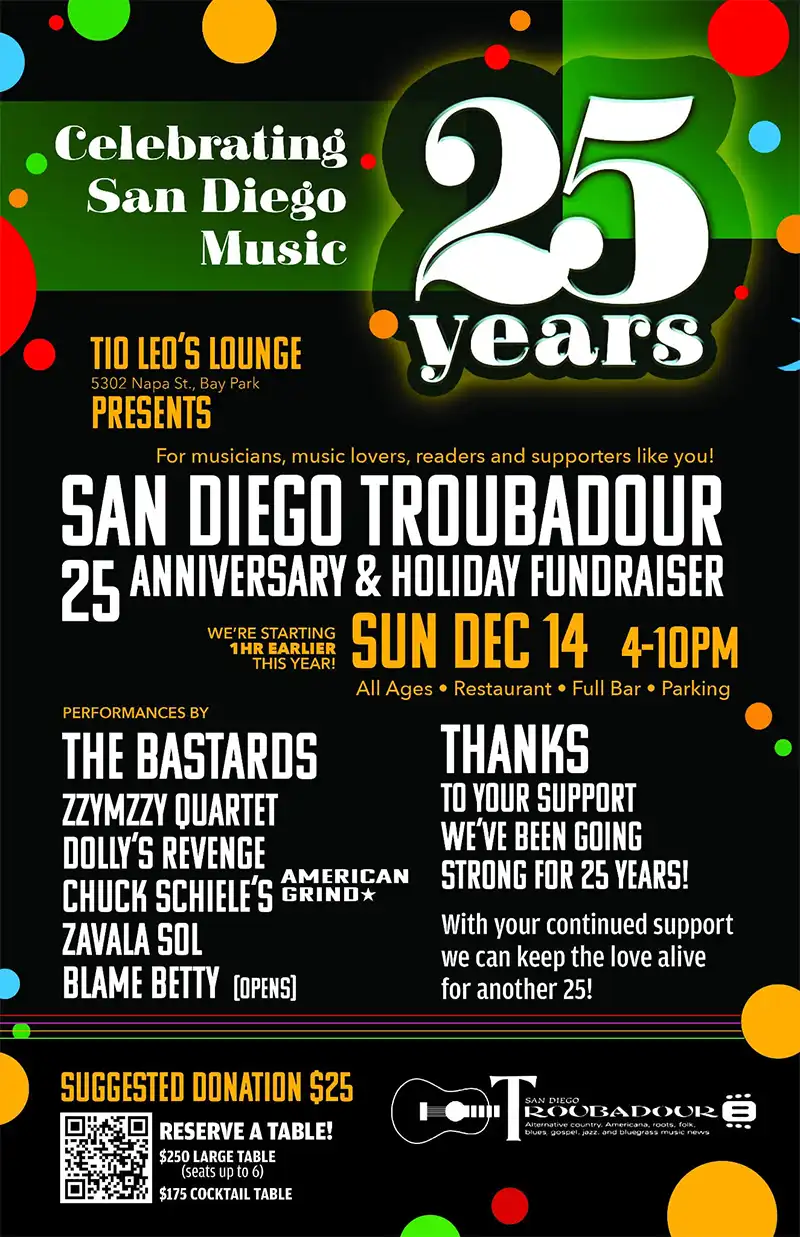Featured Stories
Cigar Box Guitars: Works of Art You Can Hear and Feel
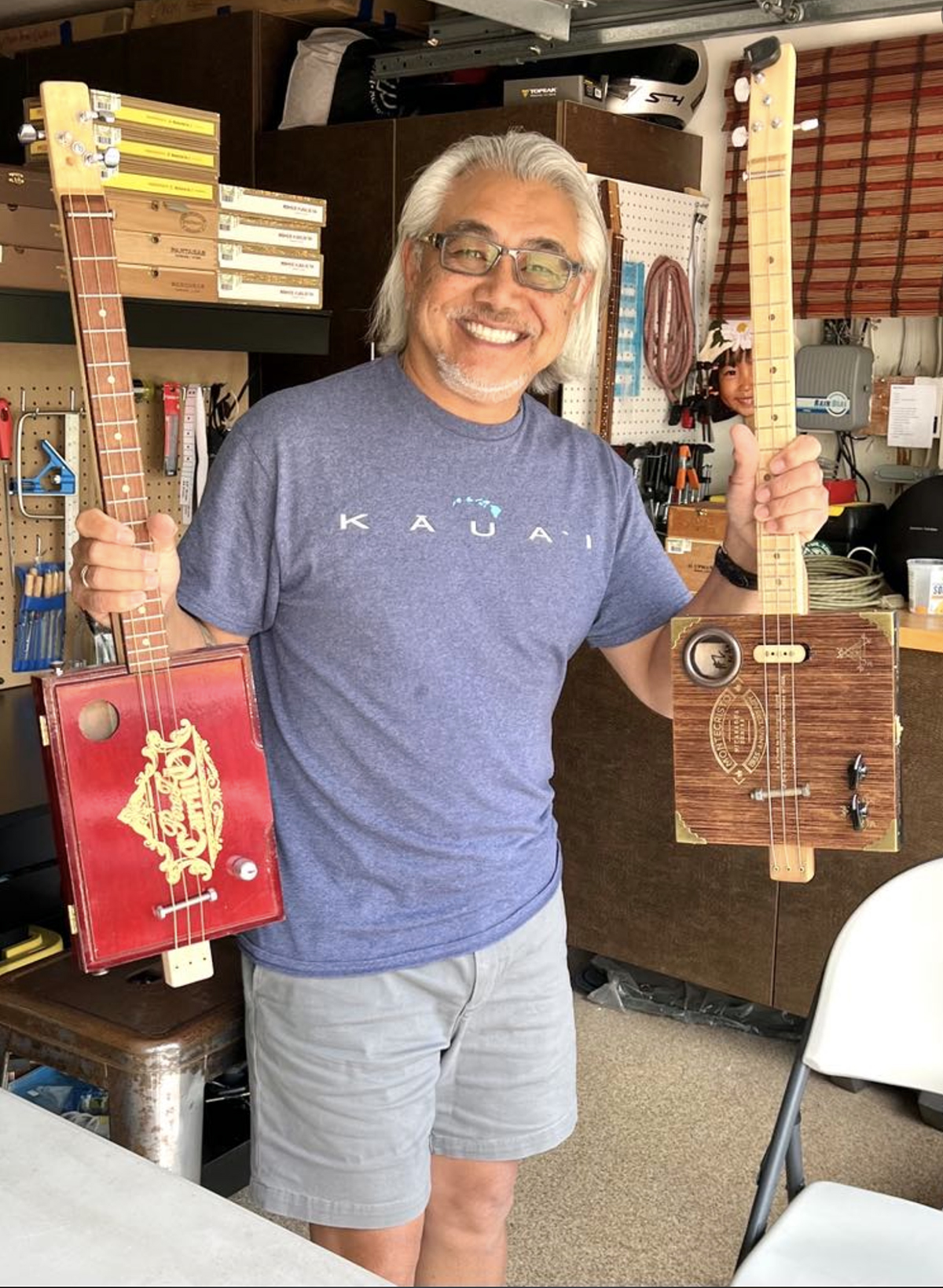
Nick Abadilla
Nick Abadilla loves a challenge and I’d wager it’s because he grew up living around the world in a military family. That adaptability, tempered by a focus on the creative, led to successful careers in graphic design, artistic direction, photography, and now, in retirement…carpentry.
As a musician, Abadilla grins when he admits that he’s just a weekend guitar hack. But his curiosity with the emotion and depth of blues music and the masters that played them eventually took Nick down a rabbit hole of early instrumentation. He says he’s always been drawn to the rough draft of things, so it comes as no surprise that music, blues music in particular is a constant in his workshop during the construction process.
We started our conversation with the early years.
Well, I was born in the Philippines, he reflects. And grew up all over the place because my dad was in the Navy… East Coast, Japan, Guam, Canada…it was all good and then we landed in San Diego, and my dad retired here. So, I’ve been here in San Diego since the late’60s, early ’70s. I grew up surfing.
You have amassed a wide-ranging skill set along the way. You’re not only a musician, but a professional photographer, a graphic designer and now you’ve started making your own instruments. Walk us through that progression.
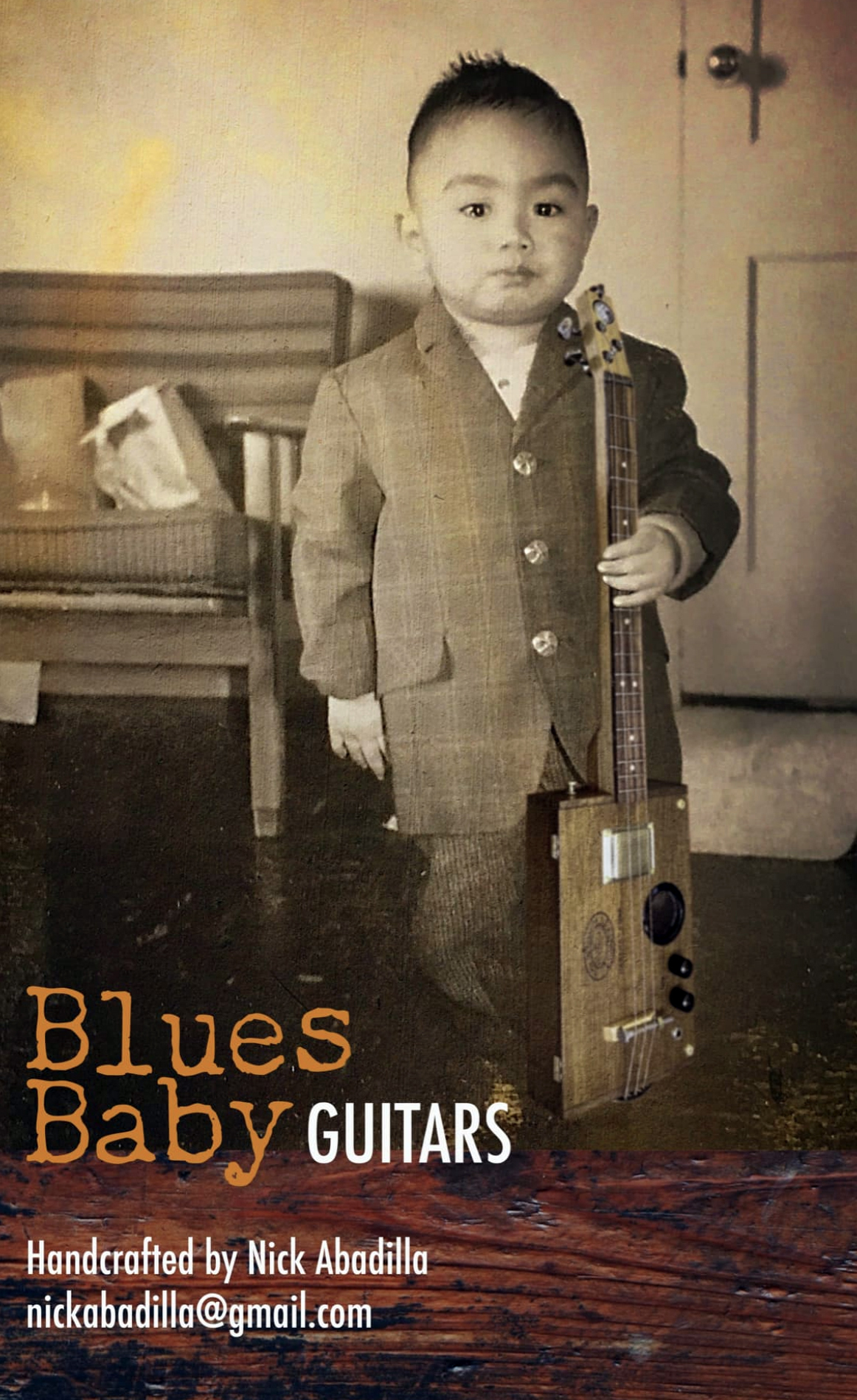
Little Nick started young! Love how he used this pic for his guitar label.
I was the odd man in the family. Out of all the family and all the traditional occupations, I was the one that was more right-brained. It started back in college that I started following my creative strengths and was drawn toward art, design, and photography, but I didn’t really pursue it. You are pushed toward more traditional directions, but I ended up compromising and stumbled into graphic design. So, most of my career was in graphic design and creative management; art director, creative director. It looked to my family like a legit desk job, because I had an office and that formal environment. It paid and I can’t complain because it did well, but it wasn’t my groove…the corporate grind that is very prevalent in the design industry, and it wore me down.
**************
“For me the cigar box was that down and dirty,
and the dirtier the better.”
—Nick Abadilla
**************
Let’s talk about the music and your guitar playing.
I’m basically just a weekend guitar hack, [laughing] who just happens to have a bunch of professional friends and that has helped. It’s helped me develop a feel for the blues, which is definitely where my wheelhouse is. But I’m just a weekend guy with a limited musical vocabulary, but I’m influenced by some very good people, locally.
What pushed you toward cigar boxes?
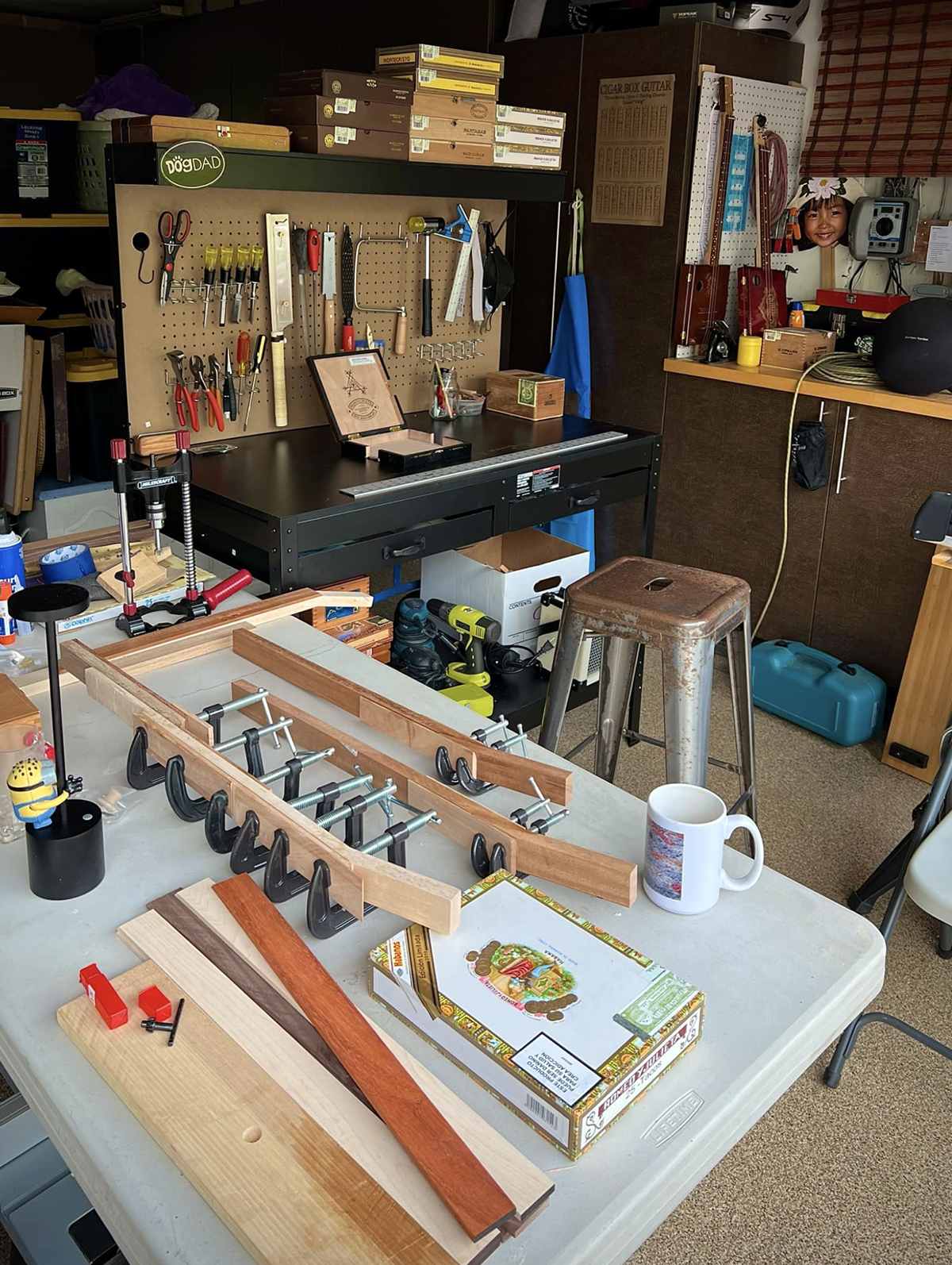
NIck’s guitar workshop.
After Covid, I tried to find a reason to play again. You remember the music scene then, it just went to zero. The only things that were available were the bar jams and I hit up those, but I felt my playing wasn’t up to my own standards. I was consistently playing badly, and I realized that the pocket I was so used to—that pre-Covid, like Chet Cannon’s jam at the Downtown Café. There was a pocket…that jump blues that was my wheelhouse because that’s what I grew up on. Now, you get into the bar jams and the blues rock kinda thing and a lot of people I didn’t know, and it didn’t feel like the blues community. Again, that’s just my perception because I don’t take anything away from these bar jams because people have fun at them. And good for them, it just wasn’t my scene and I just dropped away from them. And that lead me into revisiting the classic blues from the early 20th century, you know getting back to Lightnin’ Hopkins and Muddy Waters and then creeping into Eddie Taylor and Hubert Sumlin. And Chet would send me links because he knew I was digging deeper and somewhere in that process I stumbled into cigar box guitars and I thought, you know I’m retired I need something to do. I wanted to see if I could actually do one and that was the beginning of it.
You made your first one?
I did one really badly. [laughing] I made every mistake in the book! [laughing] But I still have that guitar and every once in a while I’ll pick it up, it still plays. And that led to number two, then by number three I started to apply some production efficiencies and that brought me up to another level….
How many instruments do you play?
Just the guitar, really. I was one of the thousands of people that had piano lessons and associated bad experiences. Most of my friends that I admire all started musically when they were younger. I learned a bunch of cowboy chords and I had guitars as a teenager but man, I wish I had started back then as far as playing blues guitar.
And back to my appeal to cigar box guitars, I’ve always loved the simplicity of it and I’ve always been drawn to the rough draft of things, whether it’s a pencil sketch or the layout of a painting or a rough draft of a song. I’ve always been able to look at that rough draft and appreciate what that artist was trying to do. For me, the cigar box was that—down and dirty and the dirtier the better. The fact that they are imperfect by nature, but you can still produce some really cool grooves because it’s all in the hands, right? The whole three-string thing, a lot of the time they’re tuned to an open tuning with an open E or an open G and your fingering is different from a regular guitar, it lends itself to blues grooving. And that really hooked me in.
I love the appearance of a cigar box guitar and the unique finger picking and slide sounds they create with just two or three strings.
All those boxes are checked, and I think garage craft has a wide appeal, the do-it yourself approach. Half the guitar is already provided with the uniqueness of the cigar box. I tend to turn away from the cigar box guitars that use electric guitar components, like the neck of an electric guitar or the bridge from an electric guitar. Yeah, they’re cool but they’re missing that home-grown essence, the simplicity. If you notice my bridge is a piece of wood and a lag bolt. I make the neck entirely from scratch from lumber. I feel I’d be cheating if I used an existing guitar neck and bolted it on there.
Tell me about the carpentry skills necessary for your process?
I’m thankful for what I learned in eighth grade woodshop. [laughing] And I had to resuscitate those skills. You have to protect the digits (fingers) because there are safety issues. You have to acquire the basic tools with the wife’s permission—table saws, router, hand tools, rasps, and hand saws. And you have to consider space constraints. A small space in the garage and the rest you move out to the driveway.
Can you discuss the tone elements of a cigar box?
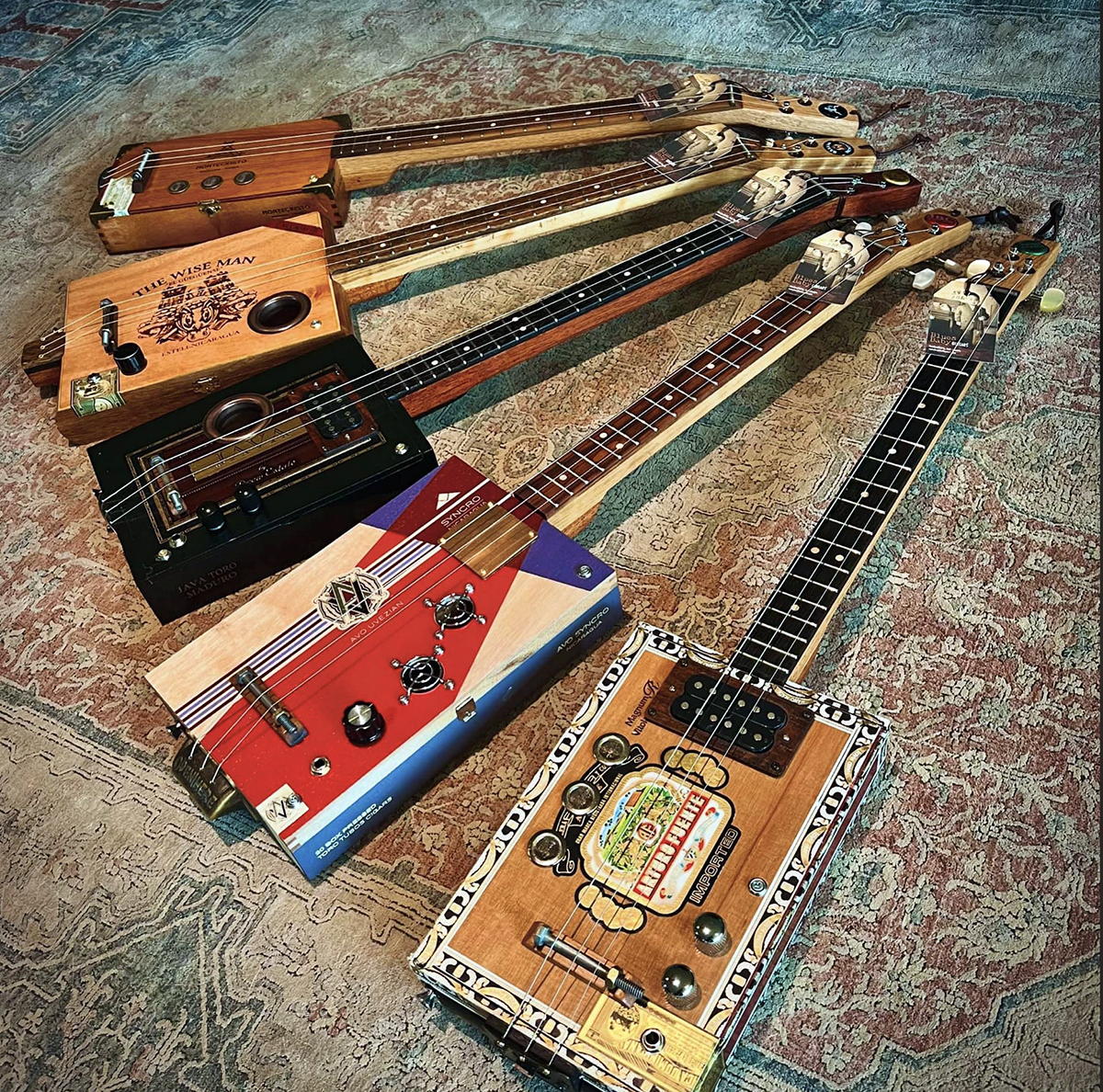
Display of NIck’s exquisite guitars, most custom made to fit the personality of the player.
People ask me what the tone is like on a cigar box guitar? It’s a box; these are not Fenders or Gibsons where they have wood bracings, it’s a box with a cheap pick-up and some strings. Volume-wise they can be just as loud; as far as stage quality, you can definitely gig with these things. Just think Samantha Fish, who was a big influence on me. She builds entire songs around them and they’re pretty simple but it’s all in how you play it. But there’s definitely a greasy sound to it.
There’s a whole laundry list of musicians that perform with cigar boxes now. You mentioned Samantha Fish, and there are others: Justin Johnson, Janiva Magness, and J.P. Soars. I asked Samantha Fish just last year about her first experience with a cigar box guitar.
It was probably in 2013…2015 something like that, Samantha said. I remember going to a festival when I was 17 and seeing these guys playing cigar box guitars, and I just thought it was a really unique sounding instrument. There’s this juxtaposition because it’s such a small guitar, but it sounds so fierce, right? I don’t know, I was just drawn to it. I bought one at this festival, where they were selling them on the midway, and it just became a thing. It was unintentional, really. I bought it to commemorate an experience. I pulled it out on a gig once and people just kind of freaked out.
**************
Getting back to the process of building a guitar, it really seems ominous to me.
With a cigar box guitar, it’s very simplistic. The wiring into the pick-up and the knob controls is very simple. If I went from start to finish, I could probably build a complete guitar in three days. There’s a thing on the guitar called the action, the string height off the finger board. How high or low it is, is called the action. Traditionally with an electric guitar, it’s low for fingering and speed. With a cigar box guitar, I have it much higher to accommodate slide playing and to be a little more forgiving. The neck width is constant, dramatically narrower and not tapered.
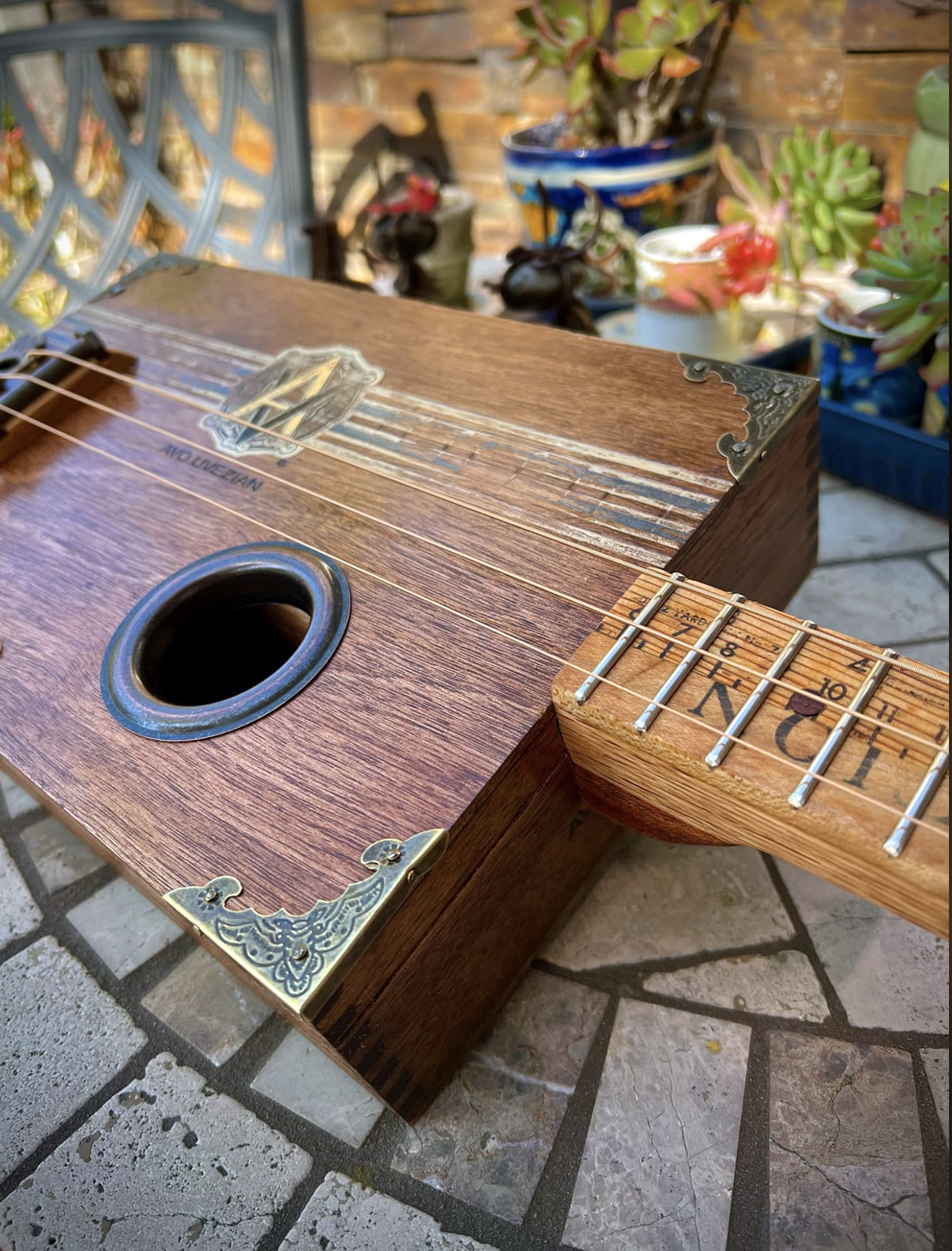
Guitar close up, using a ruler for the neck.
Another San Diego musician, Nathan James, made his guitar out of a washboard, and I’ve seen guitars made from shovels and gas cans. Have you ever experimented with other appliances or materials?
I made one out of old fence boards. I found old fencing in the crawl space of our house. They were dirty and warped but I took what I could use and milled them down to usable lengths of wood. I found a usable graphic on a piece of tin, which was a Dia de Los Muertos graphic and when I saw that I immediately thought of my friend [San Diego musician and now the proud owner of said guitar] Roxanne Coverdale-Blinn. I had always wanted to make a bass guitar, so I made a box to that graphic. It was a slow build and took months, but I always had her in mind. I love Scottie and Roxie as friends and to me they are amongst the top-shelf musicians in San Diego. It wasn’t perfect and I told her that, but it’s playable and it’s loud! That was my first non-cigar box guitar.
A good buddy of mine is a trucker and came across some really nice wine boxes up in the Sonoma Valley somewhere and asked if I could use them. I said sure. I’ve stripped them down to the logo’s that are embossed in the wood. The plan is to build wine box guitars with these. I’ve got a ton of cigar boxes, still. Once the word got out this is what I was doing, my supply comes from friends, and most are in really good condition and will eventually become guitars. I would get boxes from cigar shops, where you can go in and get five or six of them for 15 bucks.
Repurposing is the wave of the future.
I’ve had a few boxes that were kind of distressed already because they were old and beat up, but they were cool. And that added to the aesthetics of the box.
Do you need to add internal supports or bracing inside some of the boxes?
Often! With traditional cigar boxes made from MDF or paper, I’ll reinforce them with quarter-inch strips of wood inside, so structurally they hold up better. Usually lighter woods like poplar or pine end up in my scrap pile. It also adds support when you screw the neck in or the strap holders in or the pick-ups. I want these guitars to hold up because my base of friends are largely musicians, so I have to have a certain standard. They have to be playable and durable.
Your standard cigar box guitar is what, three-strings, two-strings; do you make diddley bows?
I have done several diddley bows and they’re fun…using just the one string.
Do you go to people’s houses and nail it to their front porches? [laughing]
Actually with boxes, I do feel like I’m paying homage to the elders. But to make them is very satisfying because A, it’s a lot faster but B, it’s as pure as it gets. One string and a slide, you know? Quite often people who don’t play a lick of guitar have bought my guitars, but they’re blues lovers or music lovers and they’ll just hang it on the wall.
They are works of art. And speaking of artistry and diversity of materials, have you considered working with more metals? Resonators? Nick’s Dobros?
It’s not out of the question. He shakes his head. But the possibility of cutting my hands off…right now I’m going to stick with wood. I’ll migrate to the wine box things, but I won’t abandon the cigar boxes. The logo on the box dictates the size of the guitar.
Mostly three-strings?
Mostly three-strings. I have done four-string ukuleles, but will probably stop soon. They’re fun to make, but my forte is the three-string, open-tuning guitars. I’d like to make a few more basses, but it’s a little more challenging because it’s a longer scaling and the strings flop around a little bit more and that poses a challenge. But finishing a bass guitar is quite satisfying.
You’ve been demonstrating your craft work recently.
There’s a store in Mission Hills called Lewis and Fay, a real nice kitchen and home items boutique. They offered me a space to display my guitars. They have about six of my guitars now in store. That has now turned into a series of evenings where I can go and demonstrate them for the customers. And now it’s like an informal jam session and we’ve had four of them so far. It’s fun.
It’s all about the creative experience.
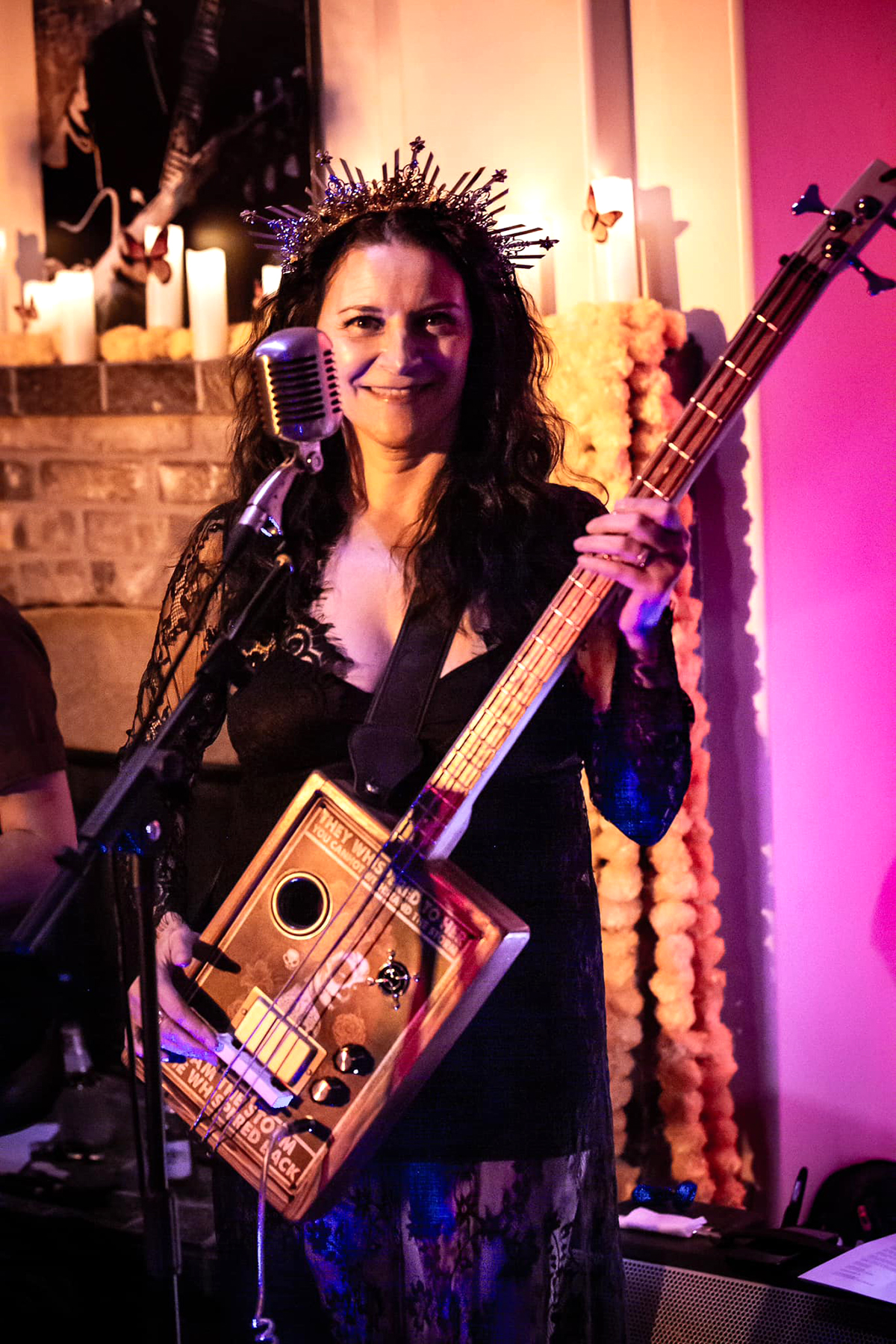
Custom made bass guitar that Nick made for Roxanne Coverdale-Blinn. Photo by Jon Naugle.
I think with cigar box guitars there’s a purity about it that is very appealing to me. What you can do with just three strings, a box and a stick. Add some electronics to it and it screams. I had the good fortune to play last year at Gator by the Bay; Chet Cannon invited me to sit in for a set with a full band, and that was a blast,
When it’s all said and done, you seem to consider your workshop a refuge…
When I’m working on these things, days on end, mornings and through the afternoon, I’m in the garage. In the background I’m playing music like Lightnin’ Hopkins and artists that I’ve heard of but not too familiar with who lived at the turn of the century; I’ll listen to album after album. I’m marinating in it as I hammer in the frets or on the drill press; I absorb all of this by osmosis. Has it helped my playing? Absolutely! Blues is all about a feel…and emotion. I subscribe to the fact that it’s not about how many notes you play or how fast you play. It’s how you play those notes. So, building cigar box guitars coupled with the music I’m soaking in, sprinkled with all these friends that I have, whom I admire, it all folds into my limited musicianship. I think it gives me a heightened appreciation of music and the blues, specifically. It helps me understand it at a different level.


